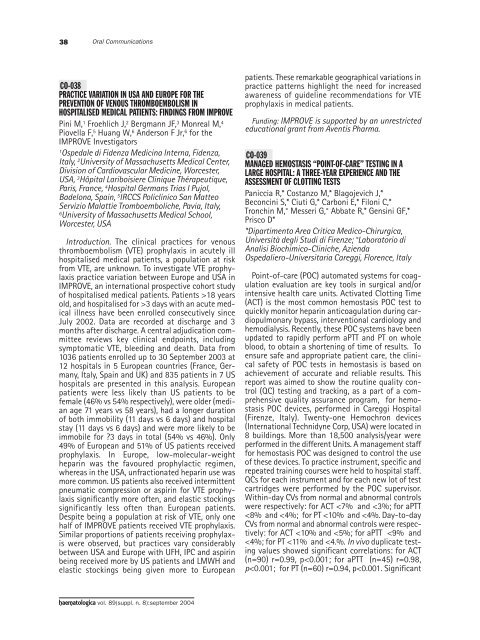Haematologica 2004;89: supplement no. 8 - Supplements ...
Haematologica 2004;89: supplement no. 8 - Supplements ...
Haematologica 2004;89: supplement no. 8 - Supplements ...
- No tags were found...
Create successful ePaper yourself
Turn your PDF publications into a flip-book with our unique Google optimized e-Paper software.
38Oral CommunicationsCO-038PRACTICE VARIATION IN USA AND EUROPE FOR THEPREVENTION OF VENOUS THROMBOEMBOLISM INHOSPITALISED MEDICAL PATIENTS: FINDINGS FROM IMPROVEPini M, 1 Froehlich J, 2 Bergmann JF, 3 Monreal M, 4Piovella F, 5 Huang W, 6 Anderson F Jr, 6 for theIMPROVE Investigators1Ospedale di Fidenza Medicina Interna, Fidenza,Italy, 2 University of Massachusetts Medical Center,Division of Cardiovascular Medicine, Worcester,USA, 3 Hôpital Lariboisiere Clinique Thérapeutique,Paris, France, 4 Hospital Germans Trias I Pujol,Badelona, Spain, 5 IRCCS Policlinico San MatteoServizio Malattie Tromboemboliche, Pavia, Italy,6University of Massachusetts Medical School,Worcester, USAIntroduction. The clinical practices for ve<strong>no</strong>usthromboembolism (VTE) prophylaxis in acutely illhospitalised medical patients, a population at riskfrom VTE, are unk<strong>no</strong>wn. To investigate VTE prophylaxispractice variation between Europe and USA inIMPROVE, an international prospective cohort studyof hospitalised medical patients. Patients >18 yearsold, and hospitalised for >3 days with an acute medicalillness have been enrolled consecutively sinceJuly 2002. Data are recorded at discharge and 3months after discharge. A central adjudication committeereviews key clinical endpoints, includingsymptomatic VTE, bleeding and death. Data from1036 patients enrolled up to 30 September 2003 at12 hospitals in 5 European countries (France, Germany,Italy, Spain and UK) and 835 patients in 7 UShospitals are presented in this analysis. Europeanpatients were less likely than US patients to befemale (46% vs 54% respectively), were older (medianage 71 years vs 58 years), had a longer duratio<strong>no</strong>f both immobility (11 days vs 6 days) and hospitalstay (11 days vs 6 days) and were more likely to beimmobile for ?3 days in total (54% vs 46%). Only49% of European and 51% of US patients receivedprophylaxis. In Europe, low-molecular-weightheparin was the favoured prophylactic regimen,whereas in the USA, unfractionated heparin use wasmore common. US patients also received intermittentpneumatic compression or aspirin for VTE prophylaxissignificantly more often, and elastic stockingssignificantly less often than European patients.Despite being a population at risk of VTE, only onehalf of IMPROVE patients received VTE prophylaxis.Similar proportions of patients receiving prophylaxiswere observed, but practices vary considerablybetween USA and Europe with UFH, IPC and aspirinbeing received more by US patients and LMWH andelastic stockings being given more to Europeanpatients. These remarkable geographical variations inpractice patterns highlight the need for increasedawareness of guideline recommendations for VTEprophylaxis in medical patients.Funding: IMPROVE is supported by an unrestrictededucational grant from Aventis Pharma.CO-039MANAGED HEMOSTASIS “POINT-OF-CARE” TESTING IN ALARGE HOSPITAL: A THREE-YEAR EXPERIENCE AND THEASSESSMENT OF CLOTTING TESTSPaniccia R,* Costanzo M,* Blagojevich J,*Beconcini S,* Ciuti G,* Carboni E,* Filoni C,*Tronchin M,° Messeri G,° Abbate R,* Gensini GF,*Prisco D**Dipartimento Area Critica Medico-Chirurgica,Università degli Studi di Firenze; °Laboratorio diAnalisi Biochimico-Cliniche, AziendaOspedaliero-Universitaria Careggi, Florence, ItalyPoint-of-care (POC) automated systems for coagulationevaluation are key tools in surgical and/orintensive health care units. Activated Clotting Time(ACT) is the most common hemostasis POC test toquickly monitor heparin anticoagulation during cardiopulmonarybypass, interventional cardiology andhemodialysis. Recently, these POC systems have beenupdated to rapidly perform aPTT and PT on wholeblood, to obtain a shortening of time of results. Toensure safe and appropriate patient care, the clinicalsafety of POC tests in hemostasis is based onachievement of accurate and reliable results. Thisreport was aimed to show the routine quality control(QC) testing and tracking, as a part of a comprehensivequality assurance program, for hemostasisPOC devices, performed in Careggi Hospital(Firenze, Italy). Twenty-one Hemochron devices(International Technidyne Corp, USA) were located in8 buildings. More than 18,500 analysis/year wereperformed in the different Units. A management stafffor hemostasis POC was designed to control the useof these devices. To practice instrument, specific andrepeated training courses were held to hospital staff.QCs for each instrument and for each new lot of testcartridges were performed by the POC supervisor.Within-day CVs from <strong>no</strong>rmal and ab<strong>no</strong>rmal controlswere respectively: for ACT
















